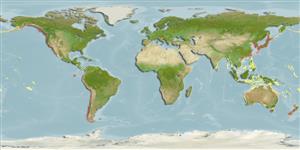Phascolosoma agassizii Keferstein, 1866
Agassiz'z peanut worm| Native range | All suitable habitat | Point map | Year 2050 |

|
| This map was computer-generated and has not yet been reviewed. |
| Phascolosoma agassizii AquaMaps Data sources: GBIF OBIS |
Google image |
No photo available for this species.
Classification / Names Common names | Synonyms | CoL | ITIS | WoRMS
Not assigned | Sipuncula | Phascolosomatidae
Environment: milieu / climate zone / depth range / distribution range Ecology
Benthic; depth range 0 - 5 m (Ref. 1815). Temperate
Distribution Countries | FAO areas | Ecosystems | Occurrences | Introductions
Indo-Pacific and the Mediterranean: Korean Peninsula.
Length at first maturity / Size / Weight / Age
Maturity: Lm ? range ? - ? cm Max length : 4.0 cm TRKL male/unsexed; (Ref. 1815)
Short description Morphology
Life cycle and mating behavior Maturity | Reproduction | Spawning | Eggs | Fecundity | Larvae
Main reference
References | Coordinator | Collaborators
Morozov, T.B. and A.V. Adrianov 2002 Fauna of Sipunculans (Sipuncula) of Vostok Bay, Sea of Japan. Russian Journal of Marine Biology 28(6):365-370. (Ref. 1815)
IUCN Red List Status
(Ref. 130435: Version 2025-1)
CITES status (Ref. 108899)
CMS (Ref. 116361)
Threat to humans
Human uses
| FishSource |
Tools
More information
Diet composition
Food consumption
Predators
Max. ages / sizes
Length-weight rel.
Length-length rel.
Length-frequencies
Mass conversion
Abundance
Maturity
Fecundity
Spawning
Eggs
Egg development
Larvae
Internet sources
BHL | BOLD Systems | CISTI | DiscoverLife | FAO(Publication : search) | Fishipedia | GenBank (genome, nucleotide) | GloBI | Gomexsi | Google Books | Google Scholar | Google | PubMed | Tree of Life | Wikipedia (Go, Search) | Zoological Record


